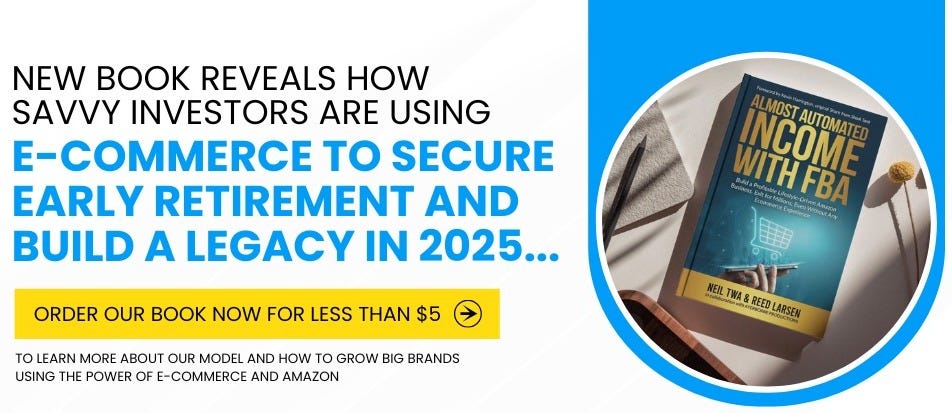Guest Post: The Ultimate Guide to Creating a Multi-Channel eCommerce Strategy
Discover how to expand your brand and boost sales with our guide on creating a successful multichannel eCommerce strategy.
Brought to you by: Seller Candy
Online shopping continues to grow rapidly, with sales climbing higher each year. The pandemic pushed this trend into overdrive, as more people discovered the convenience of buying from home. Industry experts predict that global retail e-commerce sales will surpass $8 trillion by 2027!
Today's shoppers move naturally between different online channels, from social media shops to traditional websites. That's why successful businesses are adopting a multichannel approach.
For most stores, the challenge isn't deciding whether to sell online – it's figuring out where to sell to reach the most customers. This is where creating a multi-channel ecommerce strategy comes into play. Keep on reading to learn how to position your business for success.
What is Multichannel eCommerce?
What exactly is multichannel selling? In its simplest form, it means putting your products in front of customers in several different places. Instead of just having a physical store, businesses now sell through their websites, social media accounts, and online marketplaces.
This shift has been especially powerful for manufacturers, who can now sell straight to customers instead of relying on middlemen and printed catalogs.
When businesses use multiple channels, they work on growing each one separately while keeping product details clear and consistent everywhere. Though they create specific plans for each platform and measure how well they perform, these channels often work independently rather than as part of a unified system.
Omnichannel vs. Multichannel - What's the Real Difference?
Multichannel focuses on selling products through different platforms separately. Each sales channel - like your website, social media, or store - works on its own. It tracks what sells well and where, but doesn't connect customer information between channels.
Omnichannel connects everything. It remembers what customers do across all platforms. If someone looks at shoes on their phone, then switches to their laptop, they'll see those same shoes. The shopping experience stays smooth no matter how customers shop.
Think about the data: Multichannel mainly tracks product sales. Omnichannel tracks both sales AND customer behavior. This helps create better shopping experiences.
Here's a simple way to think about it: Multichannel is like having separate stores that don't talk to each other. Omnichannel is like having one big store with many connected doors. Everything works together to help customers shop easily.
So while all omnichannel systems use multiple channels, not all multichannel setups are truly omnichannel. The key is connection versus separation.
Benefits of Multichannel eCommerce
Even traditional stores and makers now have websites or social media - that's multichannel selling at its most basic. Here's what makes it worth doing:
You reach more people who might buy your products
You're there when customers are ready to shop, no matter where they look
You make more sales across all your channels
More people learn about your brand
Customers tend to spend more per order
Your online sales keep growing
Shoppers get a better, more reliable buying experience
More Sales
Adding just one new place to sell can boost your money by 38%. Add three new spots? Your sales could jump by 190%. Here's another plus - shoppers who look up items online first tend to spend more in stores.
Better Shopping
Experience Most people shop in different ways before buying. They might check a website, look at social media, and visit a store. Being in all these places helps catch their attention. The more times people see your brand, the more likely they are to buy.
Reaching More People
Different people shop in different places:
Young folks hang out on TikTok and Instagram
Older shoppers use Facebook and X
Some like buying new things from websites
Others prefer marketplaces for repeat buys
By selling in many places, you can reach all these shoppers where they like to buy. It's that simple - more places to sell means more chances to find new customers.
Challenges of Multichannel eCommerce
When you sell through different channels, you'll face some key challenges. Here's what to watch out for:
Inventory management
Channel management
Customer experience
Managing Your Stock
When you sell in just one online store, tracking stock is simple. But add more selling channels, and it gets complicated fast. You need to update all your stock lists instantly.
Here's why: If someone buys your last three shirts in your physical store, but your website still shows them as available, you might end up with orders you can't fill.
Running Different Sales Channels
Each new channel means more work. Think about selling through your website, two social media shops, and a regular store. You'll need to:
Keep your brand looking and feeling the same everywhere
Handle orders from each place differently
Create special marketing materials for each channel
Keeping Customer Service Strong
More selling channels mean more customer messages to handle. Your service team needs to:
Watch all channels for customer questions
Answer quickly, no matter where customers reach out
Give the same helpful service everywhere
Without good planning and the right tools, these challenges can really strain your business. But knowing about them helps you prepare and handle them better.
5 Successful Multi-Channel eCommerce Strategies
Doing well in multichannel ecommerce means knowing where your customers hang out, understanding how each channel works differently, and using software that makes your team's job easier and keeps the customer experience consistent.
Here's a quick rundown of six strategies to get you started:
Pick The Right Sales Channels
You need to sell where your customers like to shop. It's that simple. Here's what to look at:
Know where your customers shop online. Some people love Amazon, others stick to Instagram. Watch where your target customers spend their time.
Think about what works for your products. Handmade items might sell better on Etsy. Tech products could do great on Amazon. Pick places where your products will stand out.
Don't just chase the big names. Yes, Amazon and eBay are huge, but smaller markets like Back Market or Mercari might be perfect for your specific products. Sometimes a smaller platform with the right customers beats a bigger one with the wrong audience.
Remember - it's better to do really well on a few channels than to spread yourself too thin trying to be everywhere.
Keep Your Brand Consistent
Your brand needs to look and feel the same everywhere you sell. This helps customers trust and remember you. Here's how to do it:
Keep everything matching. Use the same colors, logo, and way of talking on all platforms. When customers jump from your website to your Instagram, they should instantly know it's you.
Use tools to stay organized. Stick to digital asset management (DAM) platforms to help your team use the right logos and images every time. This stops mix-ups and keeps everything looking professional.
Adjust smart, not different. Each platform might need small changes, but don't change your core look. If you're known for being fun and bold, stay that way everywhere - just tweak how you show it.
The goal is simple: When people see your brand anywhere online, they should know it's you right away.
Optimise Your Product Listings
Your product listings are like your digital sales pitch. They need to grab attention and make people want to buy. Here's how to make them work:
Write descriptions that sell. Tell people why your product is special and how it helps them. Different platforms have different shoppers, so adjust your writing to match what they care about.
Go all out with your photos. Use clear, high-quality pictures from multiple angles. Show your product being used. Good photos help people make better buying decisions and return less.
Help people find you. Use the right keywords in your titles and descriptions. Each platform has its own rules about what works best - follow them to get more eyes on your products.
Just remember: A great listing shows people exactly what they're getting and why they should buy it from you.
Centralize Your Inventory Management
Selling on many platforms can get messy fast. The fix? Keep all your inventory in one system. Here's how:
Update your stock instantly. When someone buys on Amazon, your Shopify store should know right away. This stops you from selling things you don't have and keeps customers happy.
Set up stock warnings. Don't wait until you're empty. Have your system tell you when it's time to order more. This keeps you from running out or ordering too much.
Watch what sells. Look at which products move fast and which don't. Use this info to order smart. No more guessing how much to stock - let your sales data guide you.
Bottom line: One system tracking everything means fewer headaches and happier customers.
Streamline Order Fulfillment
Getting orders to customers quickly and correctly is key to keeping them happy. Here's how to do it right:
Make it automatic. Use systems that handle orders by themselves. This means fewer mistakes and faster shipping. Once you set it up, it mostly runs itself.
Ship smart. Work with good shipping companies that deliver fast and let customers track their packages. Fast, reliable shipping makes customers come back.
Make returns easy. Have a simple return policy. When people know they can easily return things if needed, they're more likely to buy and tell friends about you.
The goal? Happy customers who get their orders fast and know you'll take care of them if anything goes wrong.
Improve Customer Experience
Happy customers buy again, so great service is your secret weapon. Here's what works:
Make it personal. Use what you know about your customers to show them things they'll like. Send deals that match what they usually buy. This shows you understand them.
Help everywhere. Make it easy to get help, no matter how customers reach you. Quick, helpful answers keep people happy - whether they message, email, or call.
Reward loyal buyers. Give special deals to repeat customers and fix problems fast when they happen. Treat people right, and they'll keep coming back.
Remember: A customer who feels valued becomes your best advertiser.
Wrapping Up
Running a successful online business in 2025 means being everywhere your customers are.
We've covered how crafting a multi-channel ecommerce strategy helps you reach more customers, boost sales, and create better shopping experiences. From picking the right sales channels to keeping your brand consistent, managing inventory smartly, and delivering great customer service—every piece matters.
Still, managing multiple sales channels and resolving platform issues can feel overwhelming. That’s where Seller Candy comes in. We specialize in handling everything on Amazon Seller Central—from resolving cases and re-uploading listings to managing orders and ensuring compliance—so you don’t have to.
Ready to grow your online business without the headaches? Let Seller Candy handle the operational complexities while you focus on building your brand. Get a FREE Amazon Account Audit today!
Stay ahead of the curve! Subscribe to our newsletter today to take advantage of upcoming updates and stay informed.
Looking for more in-depth info about building wealth on Amazon? Check this out:
Book a Free Call With Neil!
Did you know we offer a no-cost, no-pressure discovery call to all our newsletter readers and podcast listeners? Yes! We’re excited to talk about your plans, your goals and how e-commerce can be the vehicle to make your dreams come true!
Step one: click here or the image below to watch our overview video and then schedule a call:
Enjoyed this issue?
Found it educational? Agree or disagree with a thing or two? Awesome! Please like and/or comment below so we can produce more content like this!






